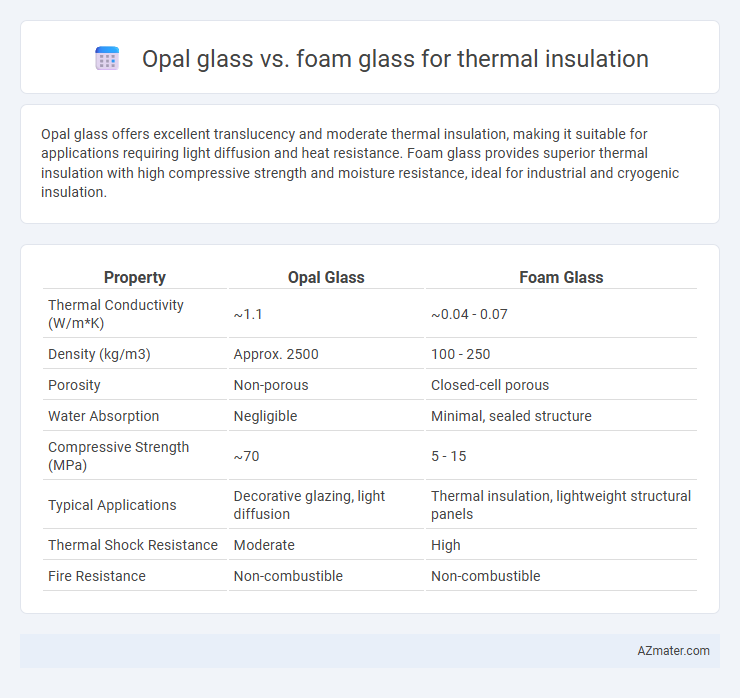Opal glass offers excellent translucency and moderate thermal insulation, making it suitable for applications requiring light diffusion and heat resistance. Foam glass provides superior thermal insulation with high compressive strength and moisture resistance, ideal for industrial and cryogenic insulation.
Table of Comparison
| Property | Opal Glass | Foam Glass |
|---|---|---|
| Thermal Conductivity (W/m*K) | ~1.1 | ~0.04 - 0.07 |
| Density (kg/m3) | Approx. 2500 | 100 - 250 |
| Porosity | Non-porous | Closed-cell porous |
| Water Absorption | Negligible | Minimal, sealed structure |
| Compressive Strength (MPa) | ~70 | 5 - 15 |
| Typical Applications | Decorative glazing, light diffusion | Thermal insulation, lightweight structural panels |
| Thermal Shock Resistance | Moderate | High |
| Fire Resistance | Non-combustible | Non-combustible |
Introduction to Opal Glass and Foam Glass
Opal glass is a type of frosted or milky glass that offers moderate thermal insulation properties, commonly used in architectural applications where diffused light and aesthetic appeal are desired alongside basic heat resistance. Foam glass, engineered from crushed glass infused with gases to create closed-cell foams, provides superior thermal insulation, high compressive strength, and moisture resistance, making it ideal for industrial and cryogenic uses. Both materials differ significantly in density, thermal conductivity, and application scope, with foam glass excelling in energy efficiency and durability for insulation purposes.
Composition and Manufacturing Processes
Opal glass thermal insulation is primarily composed of silica-based glass with added opacifiers such as titanium dioxide or tin oxide to enhance light diffusion and thermal resistance, produced through controlled melting and forming processes. Foam glass consists of crushed recycled glass combined with a foaming agent like carbon or sugar, undergoing high-temperature sintering that creates a closed-cell structure for superior thermal insulation and high compressive strength. The manufacturing of opal glass requires precise melting and cooling to achieve translucency, whereas foam glass involves foaming and annealing steps to ensure lightweight and durable insulating panels.
Thermal Insulation Properties Comparison
Opal glass exhibits moderate thermal insulation with a thermal conductivity typically around 1.0 W/m*K, making it suitable for applications requiring translucency combined with heat resistance. Foam glass significantly outperforms opal glass in thermal insulation, offering thermal conductivity values as low as 0.05 W/m*K due to its closed-cell porous structure, which effectively minimizes heat transfer. The superior insulation properties of foam glass make it ideal for industrial and building envelope applications where energy efficiency and moisture resistance are critical.
Mechanical Strength and Durability
Opal glass offers moderate mechanical strength with enhanced light diffusion properties, making it suitable for applications requiring both insulation and aesthetic appeal, while foam glass exhibits superior mechanical strength and durability due to its closed-cell structure, providing excellent resistance to compression and impact. Foam glass's high compressive strength, often exceeding 2 MPa, ensures long-term stability in harsh environments, whereas opal glass is more prone to mechanical stress and potential cracking. For thermal insulation in construction or industrial settings demanding robust load-bearing capacity, foam glass outperforms opal glass by combining insulation efficiency with exceptional structural integrity and weather resistance.
Application Areas in Construction and Industry
Opal glass is widely used in architectural applications where aesthetic diffusion of natural light and moderate thermal insulation are crucial, such as in decorative facades, skylights, and interior partitions. Foam glass provides superior thermal insulation and moisture resistance, making it ideal for industrial settings such as pipe insulation, tank insulation, and cold storage facilities. Both materials serve distinct roles in construction and industry, with foam glass favored for high-performance thermal barriers and opal glass chosen for light-transmitting insulation solutions.
Environmental Impact and Sustainability
Opal glass offers moderate thermal insulation with a lower environmental impact due to its recyclable nature and energy-efficient manufacturing process. Foam glass provides superior insulation performance, made from recycled glass, and exhibits excellent durability and resistance to moisture, contributing to longer lifespan and reduced waste. Both materials support sustainable construction, but foam glass's extended durability and higher recycled content enhance its overall ecological benefits.
Fire Resistance and Safety Performance
Opal glass offers moderate fire resistance with its ability to withstand high temperatures without releasing toxic fumes, making it suitable for decorative thermal insulation in residential and commercial buildings. Foam glass provides superior fire resistance due to its non-combustible, closed-cell structure that prevents flame spread and maintains structural integrity under extreme heat, ideal for industrial and hazardous environment insulation. Safety performance favors foam glass as it is inorganic, chemically stable, and does not emit harmful smoke, enhancing fire safety compliance in critical applications.
Cost Analysis and Economic Feasibility
Opal glass typically offers lower initial costs compared to foam glass, making it an economically feasible option for budget-sensitive thermal insulation projects. Foam glass, while more expensive upfront, provides superior durability, moisture resistance, and long-term thermal performance, potentially reducing lifecycle costs through decreased maintenance and energy savings. Cost analysis must consider project scale, installation complexities, and expected lifespan to determine the most cost-effective solution between opal glass and foam glass insulation.
Installation and Maintenance Considerations
Opal glass offers ease of installation due to its lightweight and smooth surface, reducing labor time and minimizing the risk of damage during handling. Foam glass provides excellent durability with high compressive strength and resistance to moisture, resulting in lower maintenance needs over its lifespan. Both materials require careful sealing at joints to maintain thermal performance, but foam glass's rigid structure simplifies long-term upkeep by preventing deformation and moisture ingress.
Conclusion: Choosing Between Opal Glass and Foam Glass
Opal glass offers moderate thermal insulation with aesthetic benefits, making it suitable for applications where light diffusion is important alongside insulation. Foam glass provides superior thermal resistance, exceptional moisture resistance, and durability, ideal for industrial or harsh environments requiring robust insulation. Selecting between opal glass and foam glass depends on balancing thermal performance needs with application-specific requirements such as visibility, moisture exposure, and mechanical strength.

Infographic: Opal glass vs Foam glass for Thermal insulation
 azmater.com
azmater.com